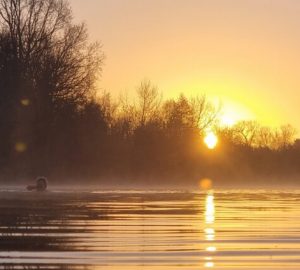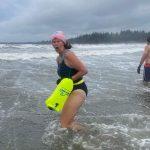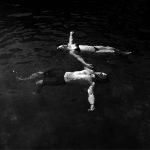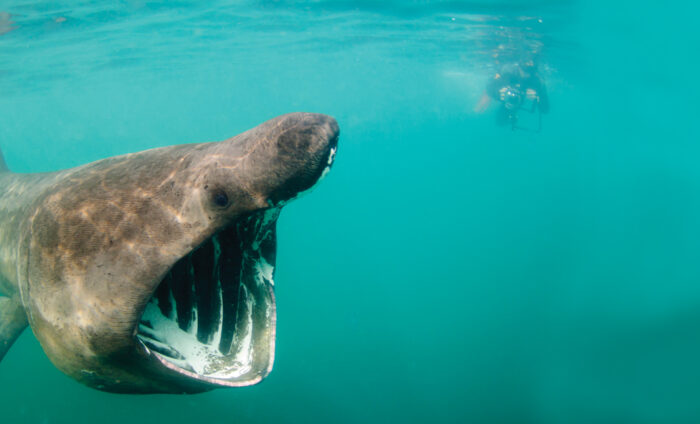
Swimming with the Sharks
We all enjoy wild swimming, but I want to inspire you with another type of swimming: wildlife swimming. All swimmers are inspired by water, so why not combine your love of the water with observing and interacting with spectacular wildlife? In the first of our series on wildlife swimming we look at swimming with basking sharks in the Hebrides, one of the most exhilarating experiences in the world and completely unique to the UK.
Basking sharks are the giants of the Atlantic. As large as a double-decker bus, they grow more than 10m long and weigh several tonnes. Thankfully these fish are plankton eaters so pose no predatory risk to humans. You’d think with a mouth over a metre wide they would be inefficient swimmers, but they are perfectly suited to their environment. Although basking sharks are relatively benign you must remember that they have powerful cousins. In classification terms they are part of the Lamniformes, which means they belong to the same family as great whites and mako sharks (ie, the really toothy kind!). This is evident when the basking sharks finish feeding and close their mouths, transforming from an obvious plankton feeder to a distinctly streamlined shark. When swimming with them this triggers deep-seated survival instincts. Always remember and recite the mantra: “They only eat plankton, they only eat plankton.
” I can’t tell you what emotions you will have when swimming with these large sharks, it’s different for everyone, but expect excitement, fear, awe, spiritualism, wonder, adrenaline, respect or a mixture of all.
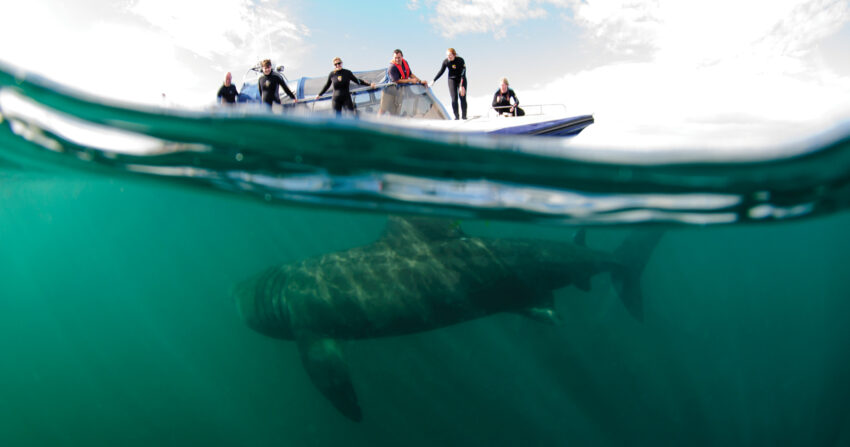
Like all swimming, there are rules to take into consideration: the sharks need to be treated with the upmost respect, both for their benefit and ours. The experience of swimming with basking sharks starts off with the briefing: the rules of engagement, the do’s and don’ts, follow the guide, no splashing, silent entry. Then the gearing up with wetsuit and hats, but also mask, fins and snorkels, hoods and gloves. After some careful study and maneuvering of the boat, the guide signals to enter the water. Suddenly you see an instantly recognisable shape. The black dorsal fin cuts through the water, directly towards you. This can be a heart-stopping moment. You look down and a dark shape comes into view. The outline of the shark appears with the bright white mouth holding the gill rakers. They use the gill rakers to filter plankton from the water – sieving for a living. The shape grows bigger and bigger and suddenly it’s really close. You freeze, not moving a muscle. Will it swallow me like Jonah? The leviathan glides past unperturbed, its sheer size and bulk is awe-inspiring. The body seems to go on forever, like a train going past, ending with the rhythmical power plant of the tail, propelling the great mass with surprising ease. Then as soon as the shark has appeared, it vanishes out of sight. The boat arrives and you climb out, exhilarated. Did that really happen or was it just a dream?
The sharks are a highly migratory species and recent tagging has shown them covering vast distances, traveling from the UK coastline to as far as Newfoundland and even west Africa during our winter. These studies have shown the Hebrides to have the largest number of basking sharks in the world. This is possibly connected with a breeding aggregation, along with availability of the rich planktonic food source. In other words the sharks all turn up in Scotland for a party and a feed. At certain times we also have them breach clean out of the water, the biggest shark in the world to do so, and a spectacular (if a little scary) sight.
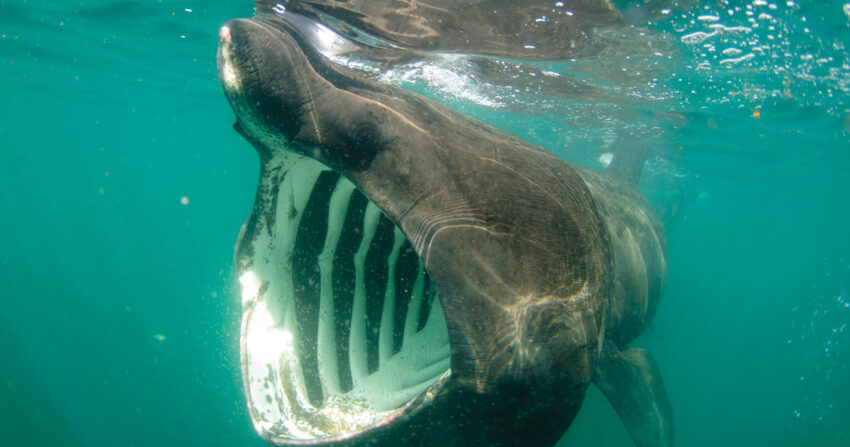
Interestingly, the abundance of sharks in the area has long been known. The last fishing operation only stopped in 1994, and Norwegian fishing fleets used to make the long journey for the summer migration. Thankfully the population (although still vulnerable) has recovered from that exploitation and the shark season now runs from May to September. Timed around the spring and summer plankton blooms, sharks can be found on their own or in large schools. If you’re really lucky, at some of the peak times 30 to 50 sharks congregate in one area – not a sight for the faint-hearted.
Water temperature in the summer in the Hebrides ranges from 10 degrees Celsius up to around 18 degrees. Even when temperatures warm up it is recommended that swimmers wear thick wetsuits to keep warm: wildlife swimming can involve a lot of patient waiting when you are observing marine life. The idea is to stay still and not splash around, and your core temperature soon drops when no energy is being expended. You should look at the thickest wetsuit you have, a good surfing wetsuit or even a diving suit. Usually the warmer people are, the happier they are.
So there you have it, a world class wildlife swim on your doorstep in the UK: a swim with the largest shark in UK waters and the second biggest in the entire world. Basking sharks are a protected species in the UK, so I’d advise against trying this swim by yourself as DIY trips can unintentionally cause harm to the sharks. Always engage a responsible operator if planning a trip and ensure they have the necessary environmental credentials and codes of conduct in place.
Shane Wasik runs Basking Shark Scotland, which provides dedicated shark sightseeing tours in Scotland as well as other wildlife swimming and sightseeing tours.
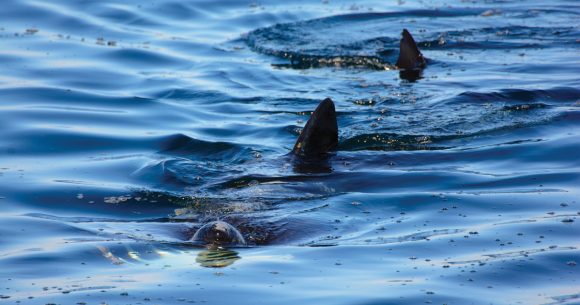
Images: Basking Shark Scotland






